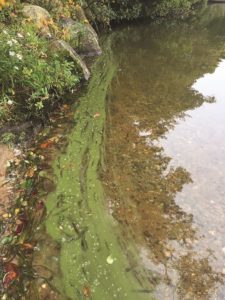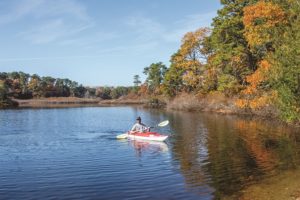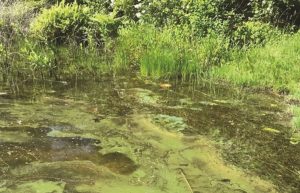WELLFLEET — With a growing number of cyanobacteria blooms occurring in ponds across Cape Cod, researchers are expanding their efforts in hopes of better understanding toxic algal blooms and how best to prevent them.
On the Outer Cape, the National Park Service (NPS) has secured funding for a two-year study of phytoplankton and zooplankton, marking the first time in 40 years that these plankton communities, of which cyanobacteria are a part, will be monitored by Park scientists.
Starting next summer, the study will be conducted alongside the National Seashore’s annual long-term water quality monitoring program, allowing researchers to compare cyanobacteria populations with detailed water quality data.
“We now have the instrumentation to measure the cyanobacteria biomass in the ponds while we are sampling water qualities, so that is a huge added data set that we have never had before,” said Sophia E. Fox, an NPS aquatic ecologist.

Cape-wide, but especially on the Outer Cape, cyanobacteria blooms are a relatively recent phenomenon. Gull Pond in Wellfleet was closed during the summer of 2019 for five days; Schoolhouse Pond and Minister’s Pond in Eastham were also closed for weeks that summer because of cyanobacteria.
Though a natural organism, cyanobacteria form toxic blooms when certain conditions — primarily high nutrient loading and warm temperatures — cause them to multiply. The toxins are especially dangerous to children and pets, and can cause a range of symptoms, from skin irritation to neurological disorders.
With global temperatures rising and excess nutrient loading from poorly managed septic systems, fertilizers, and stormwater runoff, cyanobacteria blooms are creating a new public health concern in the freshwater kettle ponds that residents and visitors treasure.
When it comes to septic systems, Andrew Gottlieb, executive director of the Association to Preserve Cape Cod (APCC), said, “We are basically using the same approach that the Pilgrims adopted when they first came to Cape Cod, which is to dig a hole in the ground and put our waste in it.
“We didn’t invest in the infrastructure necessary to treat wastewater with modern standards,” Gottlieb added, “so we are now experiencing the legacy of that series of neglectful acts.”
Unlike most other ponds on Cape Cod, the 20 named kettle ponds within the National Seashore do not have large amounts of human-derived nutrients entering their waters.
“Here in the Seashore we don’t really have the nutrient problem so much,” said Fox. As reported in the Independent last year, this has led the NPS to hypothesize that warming waters are a significant factor in the blooms. Now, Fox said, Seashore scientists “are watching whether or not we start to see these cyanobacteria blooms more frequently, because, if we do, then that is an indicator that they are really being driven by the warming and not so much by the nutrients.”
According to Fox, the surface water of Gull Pond has grown approximately 5 to 6 degrees Fahrenheit warmer in just the last few decades. The warmer temperatures mean ponds are more stratified — warm water on top of cooler, denser water beneath.
“When water cools and the algae dies,” Fox explained, “that algae settles to the bottom of the pond and partially degrades, and in that process — much like creating compost — it provides a rich source of nutrients on the pond bottom that can become resuspended in the next growing season to produce growth of a new crop of algae.”
It’s a feedback loop that is hard to break. “Finding some way to interrupt that nutrient flow cycle is what we need to do,” said Gottlieb.

Eastham has recently begun using a mitigation technique called aeration, which pushes oxygen into the water through diffusers. And the Orleans Pond Coalition has started a pilot project using microbubbles to oxygenate Sarah’s Pond, which has had cyanobacteria blooms.
“A lot of these techniques are intended to keep the pond from stratifying,” said Gottlieb. But addressing excess nutrient load is the APCC’s near-term focus.
“We have to implement better land-use practices by home owners and businesses and upgrade the quality of wastewater treatments,” Gottlieb said.
The APCC conducted a study of 93 ponds this year and found that 39 of them, or 42 percent, had unacceptable water quality — up from 39 percent the year before.
That’s a small sample size, Gottlieb said, but the study showed a fairly wide distribution of blooms in very different types of ponds. That’s why, he argued, the problem “warrants a much bigger effort than what is currently being applied.”
Following these findings, the APCC is pushing for a county-wide “208” water quality study — pursuant to Section 208 of the Clean Water Act.
Gottlieb is hopeful that newly elected county leadership will make a difference in the Cape’s water cleanup efforts.
“We are really looking forward to Barnstable County reversing a multi-year trend of divestment from looking at water quality to going back to their history of being one of the leaders in funding and supporting it,” he said.

